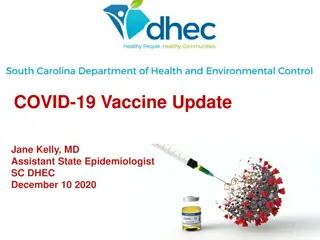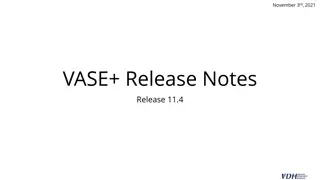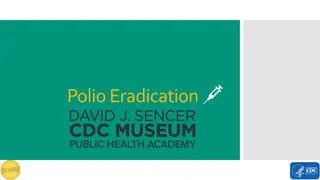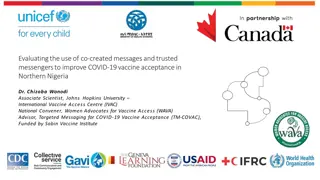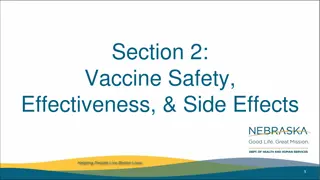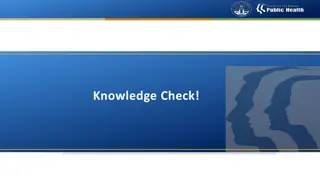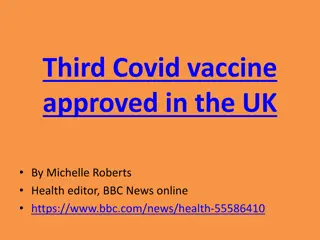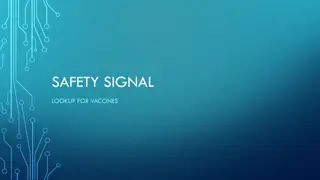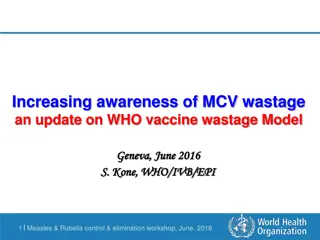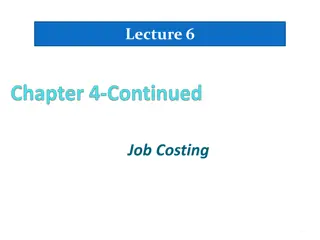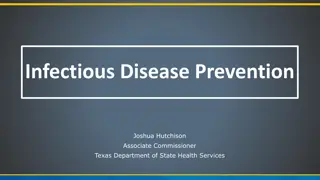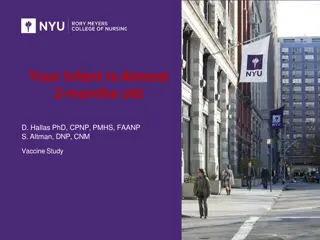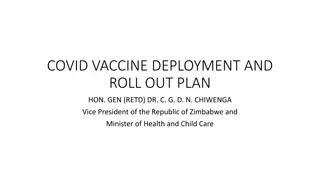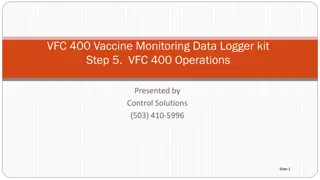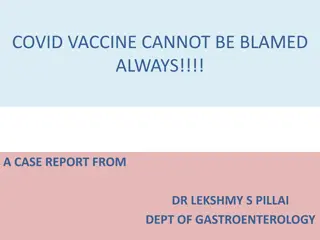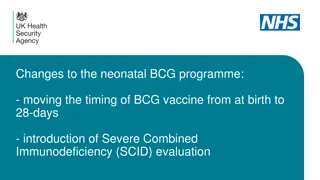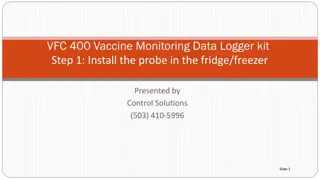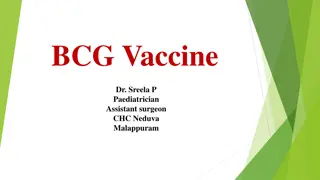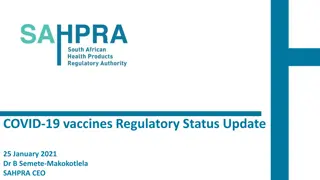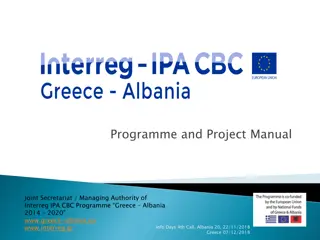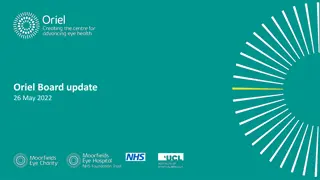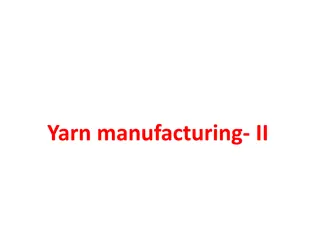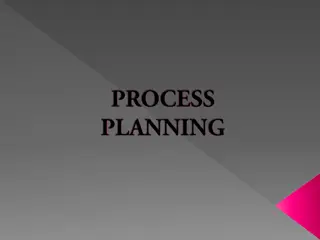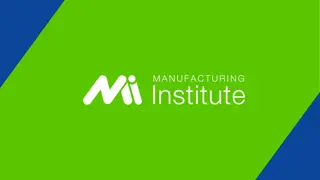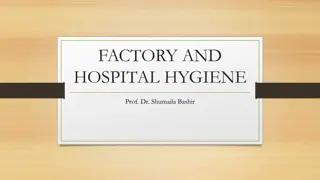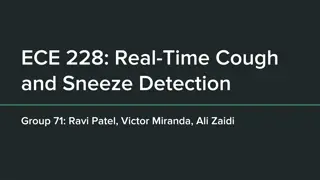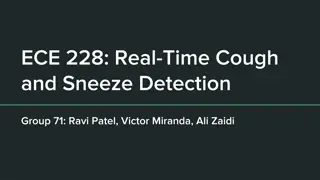Understanding Immunisation Programme and AEFI Detection in Vaccine Manufacturing Industry
The content delves into various aspects of immunisation programmes, including AEFI detection, causality assessment, reporting procedures, and implications for COVID-19 vaccination. It explores different categories of reactions following immunisation, such as quality defect-related, product-related, and coincidental events. The importance of surveillance, identification of adverse events, and preparation for mass vaccination efforts are highlighted.
Download Presentation

Please find below an Image/Link to download the presentation.
The content on the website is provided AS IS for your information and personal use only. It may not be sold, licensed, or shared on other websites without obtaining consent from the author. Download presentation by click this link. If you encounter any issues during the download, it is possible that the publisher has removed the file from their server.
E N D
Presentation Transcript
Immunisation Programme Vaccine Manufacturing Industry Immunisation AEFI Detection (reported or identified) Vaccine recipient / caregiver / vaccinator Feedback and Prevention National Department of Health South African Health Products Regulatory Authority (SAHPRA) 1 8 2 Causality Assessment National Immunisation Safety Expert Committee (NISEC) National Department of Health (NDoH) Notification and Reporting Healthcare worker 3 7 6 4 World Health Organization (WHO) 5 Management of AEFI Healthcare worker Ministerial Advisory Committees on Vaccines and Immunisation Analysis Provincial and National Team Investigation Multi-disciplinary team
Inconsistent with causal association to immunisation Consistent with causal association to immunisation Vaccine quality defect-related reaction Vaccine product-related reaction Coincidental event Caused or precipitated by a vaccine due to one or more of the inherent properties of the vaccine product Caused/precipitated by a vaccine, due to one/ more quality defects of the product An event that happens after vaccination but is not caused by the vaccine or vaccination process Implications for COVID-19 Knowledge of potential vaccine quality defects might not be sufficient for new vaccine platforms at time of registration Rapid scaling up of vaccine production poses additional potential risks Identification of exact substance causing event is needed Implications for COVID-19 Identification of rare and very rare adverse events is not sufficient at the time of COVID-19 vaccine registration More information will be needed for which AEFI surveillance has to be strengthened Implications for COVID-19 Coincidental events will be of utmost importance for COVID-19 vaccination and one of the reasons for active surveillance of AESI Because of potential comorbidities in vaccine recipients, it will be challenging to differentiate true coincidental events from COVID-19 vaccine product- related reactions or drug reactions or interactions Coincidental events can occur in healthy individuals without comorbidities Knowing population-based incidence (background rates) of pre-specified AESI helps to anticipate and respond to such events Immunisation error-related reaction Immunisation anxiety-related reaction Arising from anxiety about the immunisation and fear of injection Caused by inappropriate vaccine handling, prescribing or administration Implications for COVID-19 Vaccines will be administered on massive scale within short time interval; larger number of immunization error-related reactions are anticipated if preparation is insufficient Staff who are not familiar with immunisation might assist Multiple vaccines with different specifications for administration, dose and storage, may in be in use Implications for COVID-19 Larger number of immunisation anxiety-related reactions are anticipated due to numerous factors including o older age groups o different vaccinating environments o novelty of the vaccines and their administration modalities Example: Vasovagal syncope following vaccination
Screen for contraindications to vaccination e.g. previous anaphylaxis If any contraindication do NOT vaccinate Screen for precautions and determine if the benefits of the vaccine outweigh the risks. If any precautions vaccinate with CAUTION Donotstore and/or pack otherdiluents or medicines together with any COVID-19 vaccines to avoid reconstitution errors Always check the labels of vaccinesanddiluents before reconstitution use the diluent recommended by the manufacturer Follow manufacturer s recommendations on vaccine preparation, route & technique of administration. Check expiry- or manufacturingdate of vaccine and diluent. Check for signs of freezing. Do NOT use beyond specifications Draw the vaccine into the syringe just before vaccination and donottouch the needle to avoid contamination of the vaccine and/or the syringe Donottouch the rubbercap of the vaccine vial to avoid contamination of the vial. If reconstituted, discard open vaccine vial at end of immunisation session Do not cover the vaccinecarrier with the lid while the reconstituted vaccine vial is in the foam pad Discard vaccine if reconstituted or opened after 6 hours or at end of session, whichever comes first When in doubt, contact your supervisor for clarification. Do not hesitate to report issues or concerns when identified
Need both steps completed Important for COVID-19 vaccination Report ALL minor & severe/ serious AEFI & clusters Case Feedback & prevention of safety risks investigation of severe / serious cases & clusters Timely causality assessment Public assured of integrity of immunisation services Remedial action Programme error Within 48 hours Within 24 hours
AEFI and AESI Serious or severe cases and clusters Complete case report form (CRF) for ALL detected AEFI and AESI cases Submit CRF within 24 hours of detection or notification Complete line list Med Safety App Case investigation by multi-disciplinary healthcare team in the district Submit completed CIF and documentation to District Surveillance Officer within 48 hours Follow-up on any outstanding documentation from the case investigation Submit for causality assessment by NISEC Line list Submit weekly Feedback and Prevention 1 2 3 4 5 6 Manage AEFI/AESI Arrange for case investigation by multi- disciplinary team, to be completed within 48 hours In case of a death, immediately inform District surveillance Officer via phone Follow-up on feedback from NISEC Communicate outcome of causality assessment with vaccine recipient Implement corrective measures in the case of programmatic errors Provincial AEFI Coordinators to submit updated line list on a weekly basis to the National AEFI Coordinator Reporting AEFI Causality assessment completed by NISEC Conduct case investigation within 48 hours including the completed CIF ALL cases of AEFI and AESI: Complete and submit CRF within 24 hours



